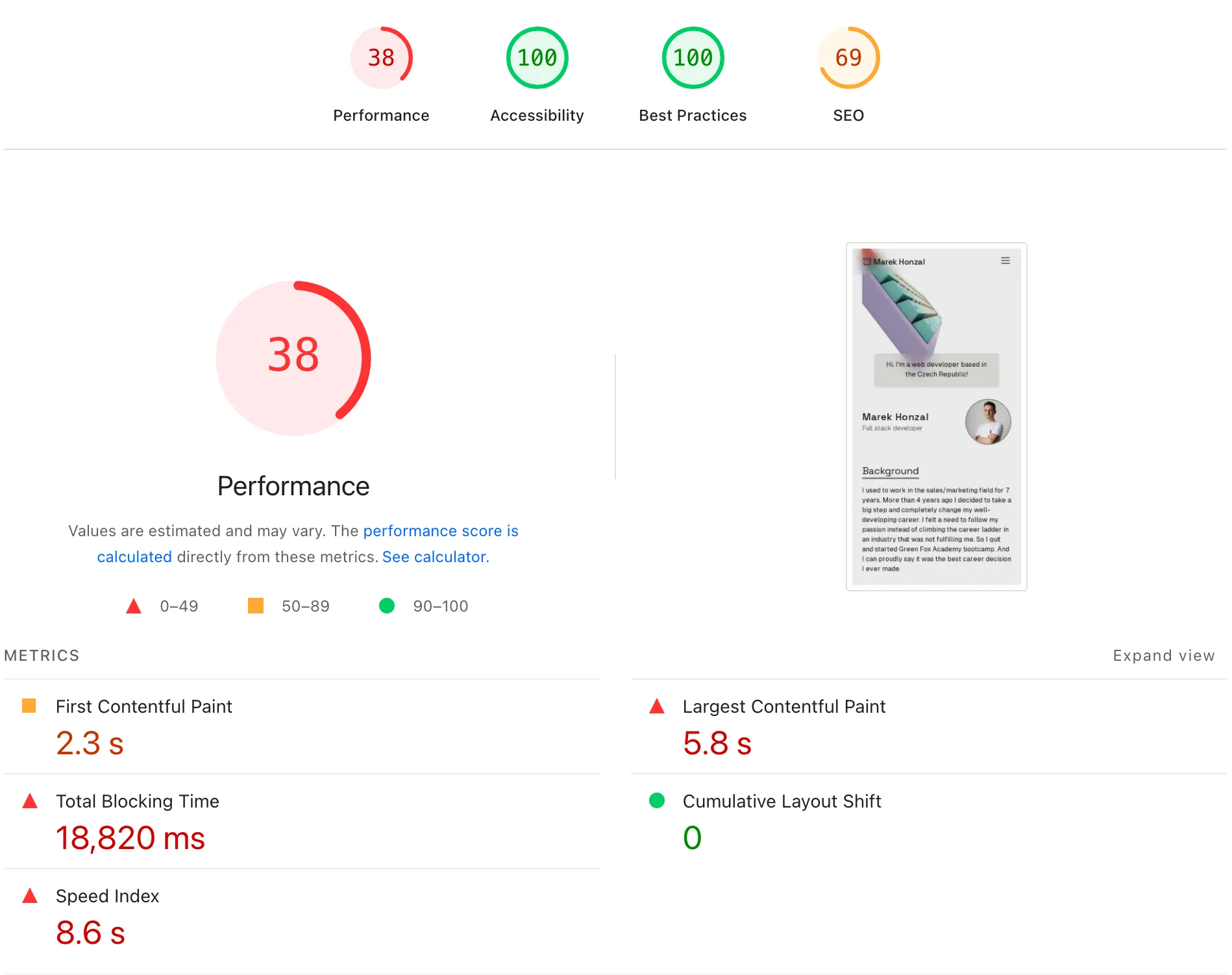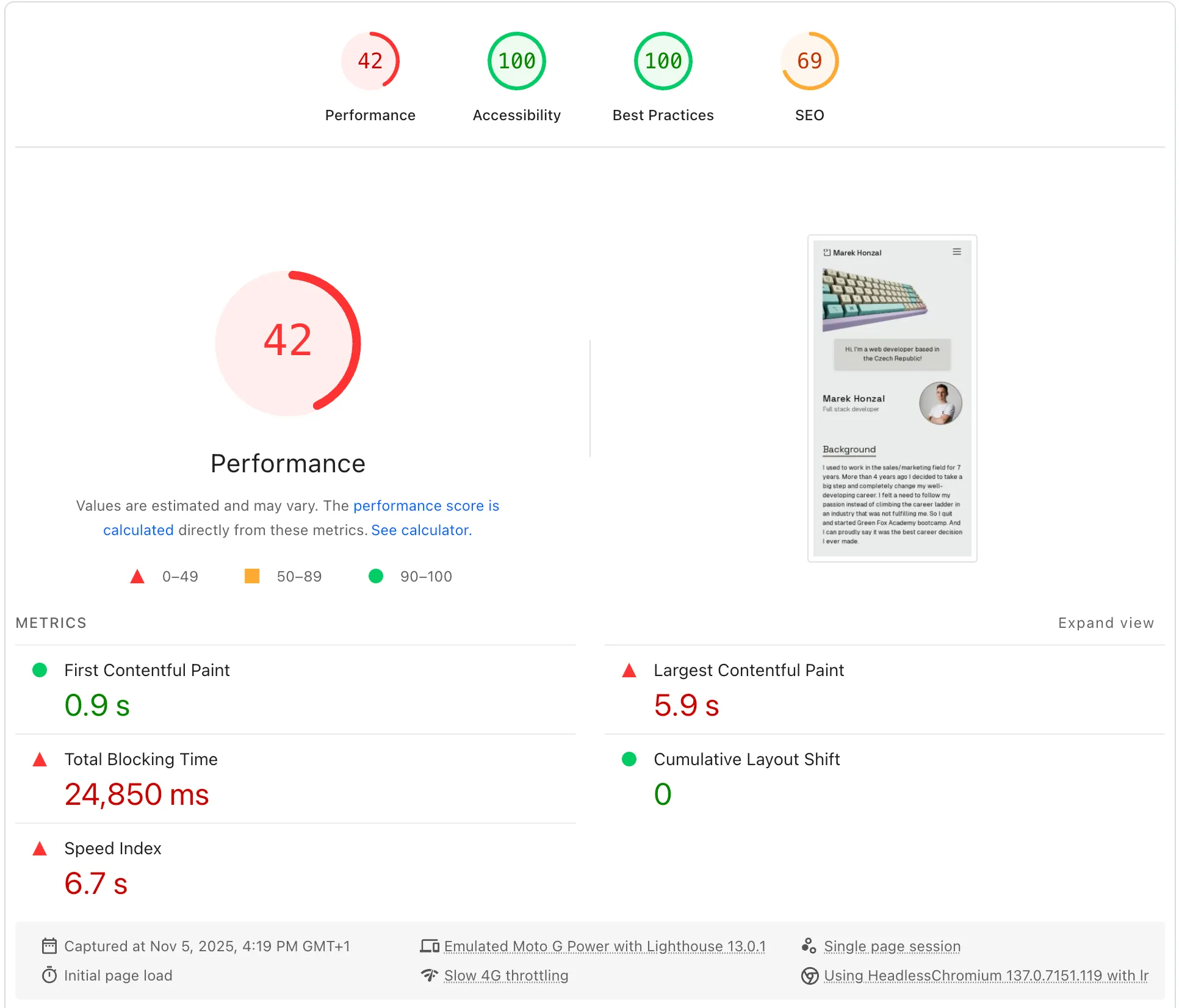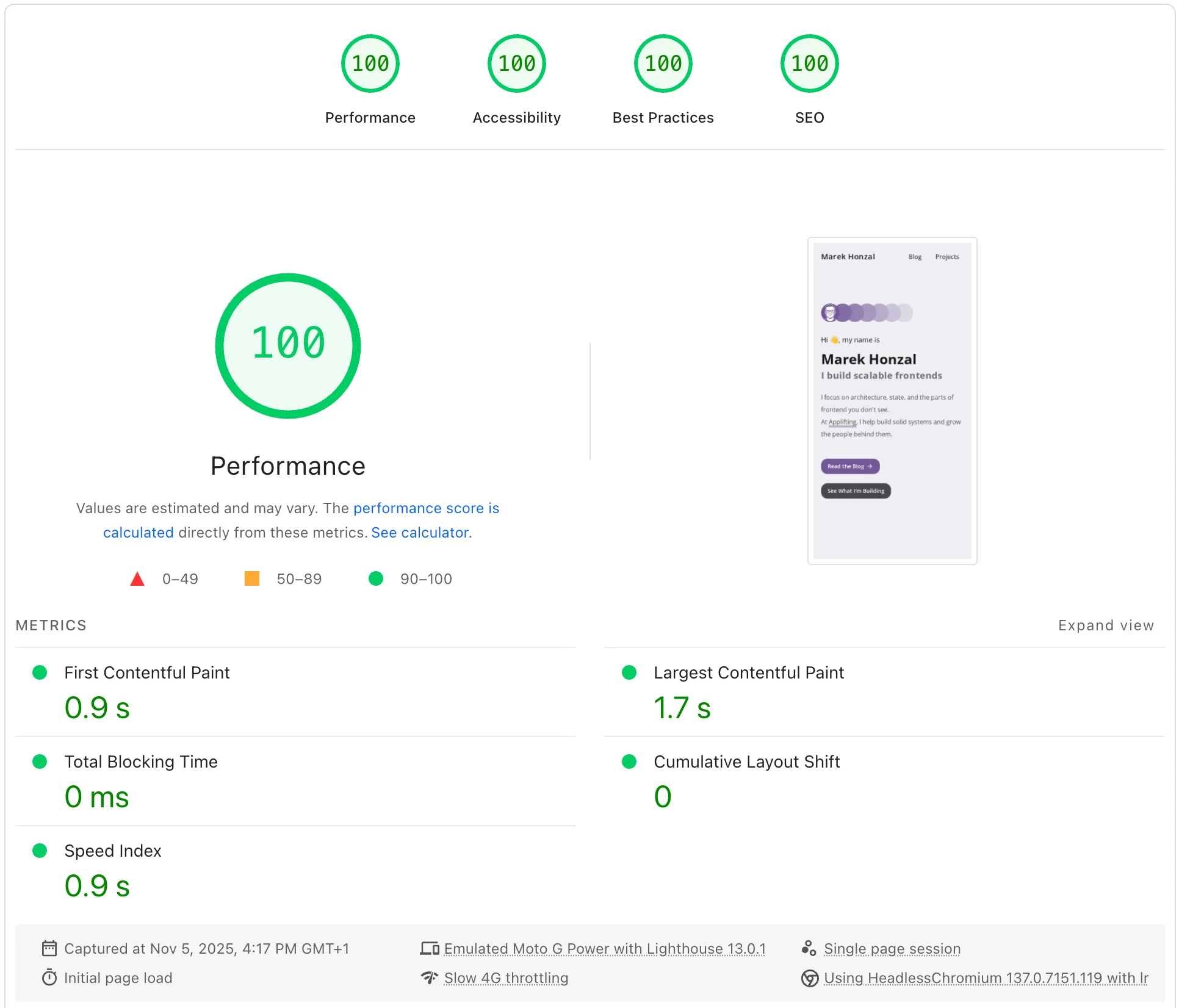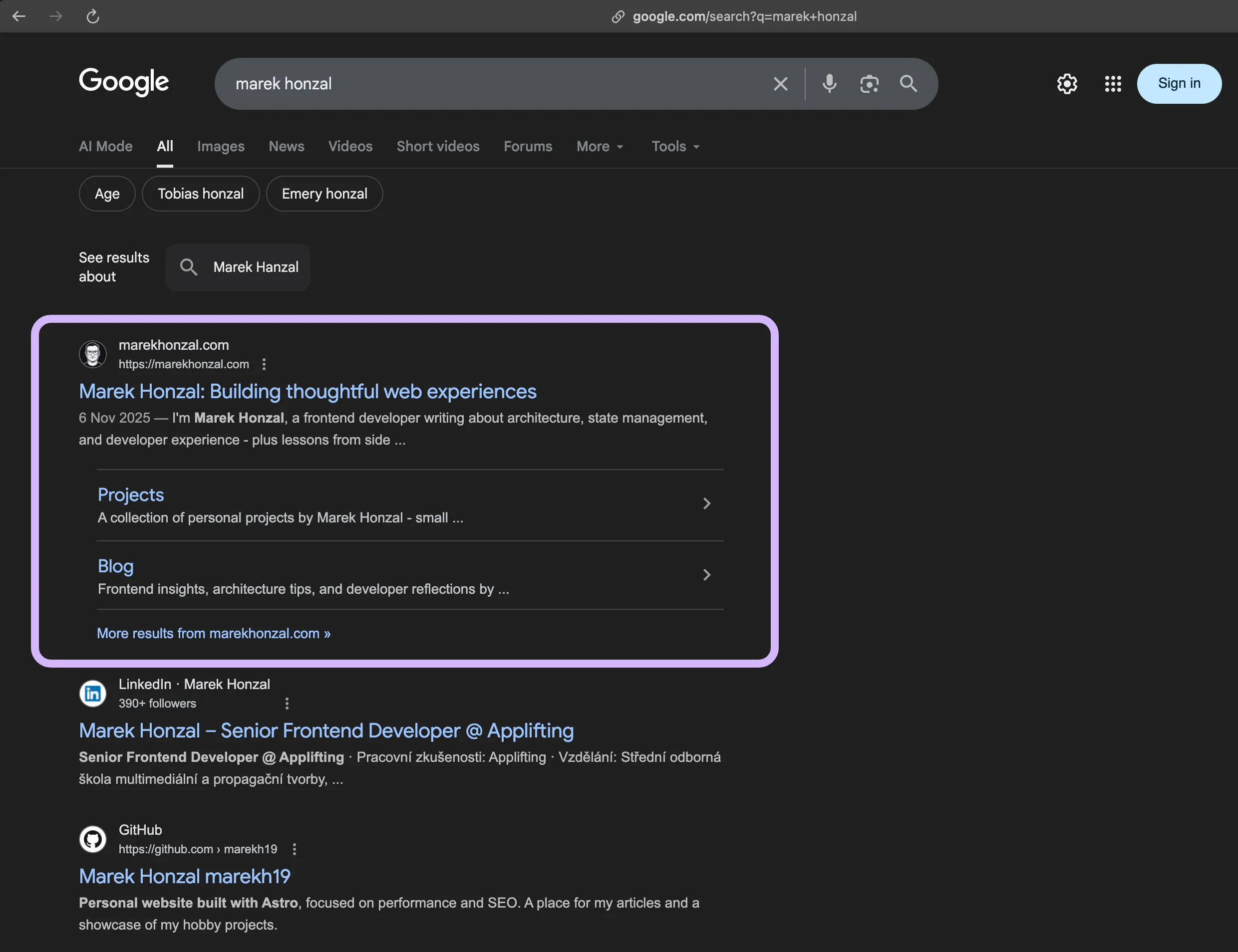TL;DR: From Overengineered Next.js to Effortless Astro
My old Next.js + Sanity CMS setup looked great on paper but made publishing a chore.
I rebuilt everything with Astro, and now it’s simpler, faster, and genuinely enjoyable
to write for.
Introduction: Why I Rebuilt Instead of Migrating
This is a personal case study of how I rebuilt my website - what I kept, what I threw away, and why the new version feels so much better.
Three years after launching my Next.js site, I realized I’d written zero blog posts.
I’d built the perfect publishing stack - and somehow, it stopped me from publishing.
The old site ran on Next.js, Sanity CMS, and the full Jamstack playbook. It was decoupled, modern, and professional. But over time, it stopped working for me. The complexity didn’t bring value - it brought friction. So I started fresh, focusing on simplicity, performance, and content.
This wasn’t a migration - I threw the old project away. Even the content changed.
For implementation details, see
Part 2: Technical Case Study.
The Next.js Era: Great Tech, Wrong Fit
When I built the first version of my site, Next.js 13 had just launched. React Server Components were the new hot thing, and I wanted to try them on a real project. Using a headless CMS felt like the natural complement: decoupled, flexible, and professional. So I paired Next.js with Sanity CMS, added a webhook for on-demand revalidation, and deployed to Vercel. Classic Jamstack.
Incremental Static Regeneration (ISR) worked flawlessly. Sanity gave me a polished content interface. For a while, I was happy.
Then the pain started.
Next.js evolved fast, and every upgrade felt like a mini-migration. Caching defaults
flipped between releases. Each new version meant relearning the framework. Meanwhile,
Sanity - though technically excellent - added friction.
Editing content through a CMS UI didn’t motivate me to write. I’m a developer; I prefer treating content as source code. Despite all that infrastructure, I never published a single post.
Performance suffered too. I couldn’t resist adding a Three.js keyboard model to the homepage - because why not show off my keyboard obsession? It looked cool but tanked Core Web Vitals. Even with canonical tags, SEO was disappointing: Google often indexed Vercel preview URLs instead of the live site. Whether it was performance, caching, or Google’s black box, the outcome was clear - my site barely surfaced in search.

The Turning Point: Asking “What Is This Doing for Me?”
After a couple of years, I looked at my site and asked: what is this actually doing for
me?
The answer was obvious: not much.
The CMS didn’t encourage me to write. The site was bloated with features I didn’t use. And
keeping up with Next.js drained motivation instead of sparking it.
When I decided to rebuild, I had two guiding principles:
- Focus on content
- Keep everything as simple as possible
Astro was the clear answer.
The Astro Era: Static by Default, Simple by Design
Astro approaches websites differently. It’s static-first and ships zero JavaScript
by default, so you start from a position of performance.
When you need interactivity, you add it explicitly through
Astro islands.
Content lives in Markdown or MDX, typed and validated through Astro’s content collections.
The build output is pure HTML - ideal for CDN caching and Cloudflare Workers.
Here’s a quick side-by-side comparison:
| Category | Old Website | New Website |
|---|---|---|
| Framework | Next.js | Astro |
| Hosting | Vercel | Cloudflare Workers |
| Styling | Tailwind CSS | Tailwind CSS |
| UI Kit | Custom components | DaisyUI |
| Content | Sanity CMS | MDX & Content Collections |
| Rendering strategy | ISR with revalidation | Pure Static Generation |
| Interactivity | React | Preact via Astro islands |
Astro fit perfectly. It let me drop the CMS and write MDX directly in my editor.
It gave me static HTML by default, with Preact islands for small bits of interactivity.
And it shipped with thoughtful defaults: sitemap, RSS, Shiki syntax highlighting, image
optimization - all out of the box.
Deployment to Cloudflare Workers took minutes.
What Changed: Everything Except TypeScript and Tailwind
This was a complete rebuild - not a migration. Only two technologies survived: TypeScript and Tailwind CSS. They’re my constants in any project.
Everything else changed. The switch from Next.js to Astro dropped React Server Components and ISR complexity. Moving from Sanity CMS to MDX brought content into my repo, versioned and editable in my IDE.
Hosting on Cloudflare Workers was effortless thanks to Astro’s static output. And I replaced custom UI components with DaisyUI for faster prototyping.
Most importantly, I ditched the Three.js keyboard that murdered performance. Now, the homepage weighs under 300 kB uncompressed, scores perfectly in Lighthouse, and finally gets indexed correctly by Google.
But the real win isn’t metrics - it’s motivation. Writing MDX feels natural, like writing code - exactly what I wanted.
Before: heavy CMS, ISR debugging, and a bloated homepage.
After: static HTML, MDX content, and instant deploys.
The Results (So Far)
Measured on 2025-11-05
PageSpeed Insights Comparison
Source: PageSpeed Insights (pagespeed.web.dev)


Homepage Weight Comparison
Source: Cloudflare Radar (radar.cloudflare.com)


Google Search
Updated on .
With my old website, Google never properly indexed the page or ranked it even in the top five results for my name. Now, just three weeks after publishing the new site, I’m already seeing solid SEO performance that I never achieved with the previous setup.
Conclusion: Simplicity Is a Feature
I hope this gave you some insight into what I learned while rebuilding my website with Astro. I genuinely enjoy working with it - it’s now my default choice for any static (or mostly static) site.
Astro isn’t right for every project - I wouldn’t use it for a highly interactive dashboard, for example. But for content-heavy, static-first websites, it’s a joy.
If I were starting a new project today that combined a marketing site with an internal app, I’d consider a hybrid setup: Astro for landing pages, React SPA for the app, and a shared component library in a monorepo.
The best part? I finally feel motivated to publish again.
Writing MDX feels like working with source code - I get syntax highlighting, version control, and my favorite editor. No CMS UI to context-switch into, no webhook delays, no “did it revalidate?” anxiety. It removes friction in a way Sanity never did - despite being technically excellent.
Sometimes you outgrow your own stack.
Simplicity is a feature.
Tools should encourage your habits, not fight them.
Curious about how it’s built?
👉 Read Part 2: Technical Case Study.